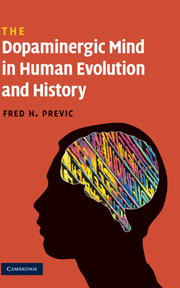Book contents
4 - Dopamine and mental health
Published online by Cambridge University Press: 27 July 2009
Summary
The “hyperdopaminergic” syndrome
Despite the many positive dopaminergic traits described in Chapter 3, the dopaminergic story has another, darker side. Whereas too little dopaminergic transmission in disorders such as Parkinson's disease and phenylketonuria is debilitating to motor and intellectual functioning, excessive dopamine activity in one or more brain systems has been implicated in an even larger number of prominent neuropsychological disorders – including attention-deficit disorder (also known as attention-deficit/hyperactivity disorder when accompanied by hyperactivity), autism, Huntington's disease, mania (also known as hypomania and bipolar disorder when it alternates with depression), obsessive-compulsive disorder, schizophrenia, and Tourette's syndrome. Other hyperdopaminergic disorders include substance abuse (highly associated with attention-deficit/hyperactivity disorder and bipolar disorder) and stuttering (linked to Tourette's syndrome). All of the hyperdopaminergic disorders are closely related to one another in terms of their co-morbidities and symptoms, and more than one set of hyperdopaminergic symptoms are surprisingly often found in the same individual (e.g. autism with obsessive-compulsive and Tourette's features; mania with schizophrenic-like psychosis and obsessive-compulsive behavior) or within families. The various hyperdopaminergic disorders also are highly amenable to the same pharmacological interventions (principally D2 receptor-blocking drugs). In fact, drugs that decrease dopamine levels in either the brain generally or in a specific system (e.g. the ventromedial one) are the main or secondary pharmacological treatment of choice in every hyperdopaminergic disorder except for Huntington's desease.
Dopamine excess contributes to the motor symptoms (e.g. hyperactivity, tics, motor stereotypies), delusions and hallucinations, and social withdrawal found to varying degrees in the above disorders.
- Type
- Chapter
- Information
- The Dopaminergic Mind in Human Evolution and History , pp. 75 - 100Publisher: Cambridge University PressPrint publication year: 2009

